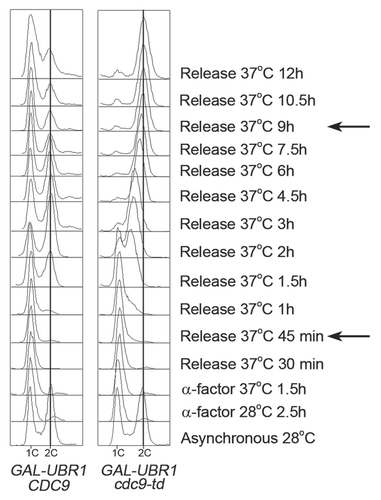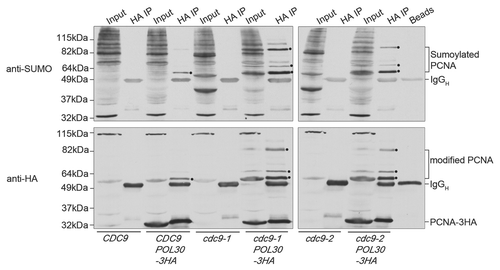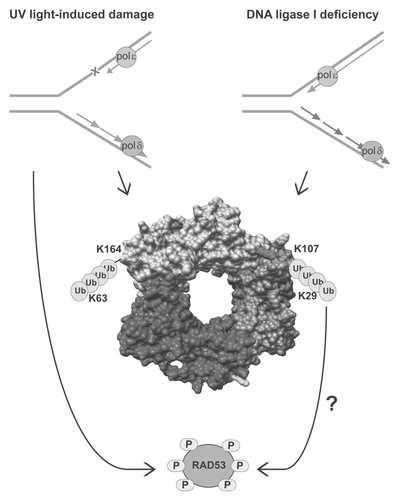Figures & data
Figure 1 DNA ligase I is required for S phase progression. Asynchronous cultures of ABy010 (GAL-UBR1 CDC9) and ABy008 (GAL-UBR1 cdc9-td) were grown at 28°C and arrested in G1 with α-factor. After 2 hours, Ubr1 expression was induced with 2% galactose for 30 min. Subsequently, cultures were shifted to 37°C in medium containing α-factor and 2% galactose. After 90 min, cells were released from G1 for 12 hours. DNA content at indicated time was monitored by flow cytometry and the vertical line indicates a 2C DNA content. The black arrows mark entry into S phase and completion of DNA replication in cdc9-td mutants, respectively.

Figure 2 PCNA is sumoylated in cdc9 mutants. Wild-type (CDC9) and cdc9 mutants (cdc9-1 and cdc9-2) expressing PCNA-3HA were grown asynchronously at 25°C and shifted to 35°C for 3 hours. Whole-cell extracts were immunoprecipitated with anti-HA conjugated agarose beads (Sigma). Both unmodified and modified PCNA was detected with an anti-HA antibody (Covance, 16B12). Sumoylated PCNA was detected with an anti-SUMO antibody (gift from Xiaolan Zhao, Memorial Sloan-Kettering Cancer Center). The black dots mark prominent sumoylated PCNA bands. IgGH indicates the immunoglobulin heavy chain. Mono-ubiquitinated PCNA is visible in darker exposures around 42kDa in cdc9 mutants with HA-tagged PCNA (only visible as a faint band in this exposure). cdc9-1 is a more stringent allele than cdc9-2,Citation12 and thus sumoylation of PCNA is more prominent in this mutant.

Figure 3 Damage-dependent PCNA ubiquitination in budding yeast. DNA synthesis occurs in a semi-discontinuous manner. Nascent DNA on the leading strand is synthesized by pol ε, whereas pol δ is required to synthesize Okazaki fragments (short arrows) on the lagging strand. In response to UV light-induced damage, which causes pyrimidine dimers on the template DNA (red X, left), PCNA is ubiquitinated at lysine (K) 164 and the poly-ubiquitin chain is linked through K63. Activation of the S phase checkpoint by UV damage is independent of PCNA ubiquitination at K164. In contrast, PCNA is ubiquitinated at K107 and the poly-ubiquitin chain is linked through K29 in response to DNA ligase I deficiency, which accumulates persistent nicks due to unligated Okazaki fragments (red arrows, right). PCNA ubiquitination at K107 appears to be a prerequisite for activation of the S phase checkpoint, illustrated by hyperphosphorylation of Rad53. The importance of the K29-linked poly-ubiquitin chain and how PCNA ubiquitination results in activation of the S phase checkpoint is still unknown. The S. cerevisiae homotrimeric PCNA structure (PDB ID 2OD8) was generated using Chimera software program.Citation80 Ub denotes ubiquitin. K164 and K107 on each of the subunits are indicated as yellow and red surfaces, respectively.
